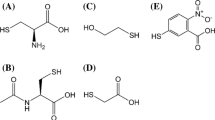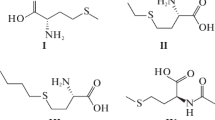Abstract
Ion-exchange LC and spectroscopic supporting techniques have been successfully used to study the kinetics and mechanism of oxidation reactions of sele-nomethionine (SeMet). Oxidation of selenomethionine with both cyanogen bromide (CNBr) and hydrogen peroxide (H2O2) proceeds through a stable intermediate which undergoes cyclization and C-Se bond cleavage to form 2-amino-4-butyrolactone. This stable intermediate was identified by IR spectroscopy as methionine dihydroxy selenide. The CH3-Se moiety of SeMet formed methyl selenic acid upon reaction with H2O2 and methyl selenocyanate (CH3SeCN), characterized by GC-MS, for the reaction with CNBr. Both reactions were of apparent first order with respect to the concentration of SeMet. A rate constant (k1) of 4.0×l0−3s−1 for the reaction of SeMet with H2O2 and 4.0 ×10−4s−1 for the reaction with CNBr were determined at a temperature of 22°C. Oxidation of methionine (Met) gives disparate kinetics and oxidation products from SeMet. Thus the differential rate method can be utilized to quantitatively separate SeMet in biological samples in the presence of much higher concentrations of Met.
Similar content being viewed by others
References
Gross E, Witkop B (1961) J Am Chem Soc 83: 1510
Wolf WR, LaCroix DE, Slagt ME (1992) Anal Lett 25: 2165
Wolf WR, Zainal HA, Unpublished results
Shepard L, Huber RE (1969) Can J Biochem 7: 875
Scala J, Williams HH (1964) J Chromatogr 15: 546
Klyman DL, Gunther WH (eds) (1973) Organic Selenium Compounds: their chemistry and biochemistry, Wiley, New York
Mottola HA, Perez-Bendito D (1994) Anal Chem Fundam Rev 66: 131 R
Pickering Laboratories Product Bulletin #2 (1986) Pickering Laboratories, Mountain View, CA, USA
Benson JR, Hare PE (1976) Proc Nat Acad Sci 72: 619
Pickering MV (1989) LC GC 7: 484
McFarlane W (1971) J Organ Chem 36: 2561
Zainal HA, Wolf WR (1995) Trans Metal Chem 20: 20
Socrates G (1980) Infra red characteristic group frequencies. Wiley, New York
Gould ES, Holt, Rinehart, Winston (1959) Mechanism and structure in organic chemistry
Krief A, Hevesi L (1988) Organoselenium chemistry. Springer, Berlin Heidelberg New York
Personal communication (Sigma Co.)
Author information
Authors and Affiliations
Rights and permissions
About this article
Cite this article
Zainal, H.A., LaCroix, D.E. & Wolf, W.R. Utilization of Chromatographic and spectroscopic techniques to study the oxidation kinetics of selenomethionine. Fresenius J Anal Chem 356, 311–314 (1996). https://doi.org/10.1007/s0021663560311
Received:
Revised:
Accepted:
Issue Date:
DOI: https://doi.org/10.1007/s0021663560311




